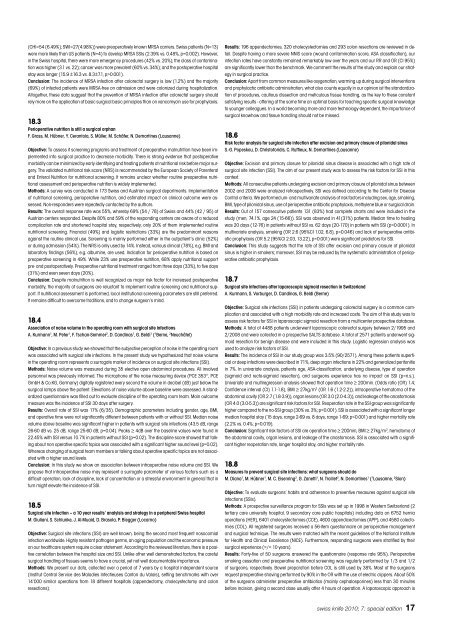Anorectal Manometry in 3D NEW! - Swiss-knife.org
Anorectal Manometry in 3D NEW! - Swiss-knife.org
Anorectal Manometry in 3D NEW! - Swiss-knife.org
You also want an ePaper? Increase the reach of your titles
YUMPU automatically turns print PDFs into web optimized ePapers that Google loves.
(CHI=54 [6.49%]; SWI=27[4.98%]) were preoperatively known MRSA carriers. <strong>Swiss</strong> patients (N=13)<br />
were more likely than US patients (N=4) to develop MRSA SSIs (2.39% vs. 0.48%, p=0.002). However,<br />
<strong>in</strong> the <strong>Swiss</strong> hospital, there were more emergency procedures (42% vs. 20%); the class of contam<strong>in</strong>ation<br />
was higher (3.1 vs. 22); cancer was more prevalent (60% vs. 34%); and the postoperative hospital<br />
stay was longer (15.9 ±16.3 vs. 8.3±7.1, p>0.001).<br />
Conclusion: The <strong>in</strong>cidence of MRSA <strong>in</strong>fection after colorectal surgery is low (1.2%) and the majority<br />
(69%) of <strong>in</strong>fected patients were MRSA-free on admission and were colonized dur<strong>in</strong>g hospitalization.<br />
Altogether, these data suggest that the prevention of MRSA <strong>in</strong>fection after colorectal surgery should<br />
rely more on the application of basic surgical basic pr<strong>in</strong>ciples than on vancomyc<strong>in</strong> use for prophylaxis.<br />
18.3<br />
Perioperative nutrition is still a surgical orphan<br />
F. Grass, M. Hübner, Y. Cerantola, S. Müller, M. Schäfer, N. Demart<strong>in</strong>es (Lausanne)<br />
Objective: To assess if screen<strong>in</strong>g programs and treatment of preoperative malnutrition have been implemented<br />
<strong>in</strong>to surgical practice to decrease morbidity. There is strong evidence that postoperative<br />
morbidity can be m<strong>in</strong>imized by early identify<strong>in</strong>g and treat<strong>in</strong>g patients at nutritional risk before major surgery.<br />
The validated nutritional risk score (NRS) is recommended by the European Society of Parenteral<br />
and Enteral Nutrition for nutritional screen<strong>in</strong>g. It rema<strong>in</strong>s unclear whether rout<strong>in</strong>e preoperative nutritional<br />
assessment and perioperative nutrition is widely implemented.<br />
Methods: A survey was conducted <strong>in</strong> 173 <strong>Swiss</strong> and Austrian surgical departments. Implementation<br />
of nutritional screen<strong>in</strong>g, perioperative nutrition, and estimated impact on cl<strong>in</strong>ical outcome were assessed.<br />
Non-responders were repeatedly contacted by the authors.<br />
Results: The overall response rate was 55%, whereby 69% (54 / 78) of <strong>Swiss</strong> and 44% (42 / 95) of<br />
Austrian centers responded. Despite 80% and 59% of the respond<strong>in</strong>g centers are aware of a reduced<br />
complication rate and shortened hospital stay, respectively, only 20% of them implemented rout<strong>in</strong>e<br />
nutritional screen<strong>in</strong>g. F<strong>in</strong>ancial (49%) and logistic restrictions (33%) are the predom<strong>in</strong>ant reasons<br />
aga<strong>in</strong>st the rout<strong>in</strong>e cl<strong>in</strong>ical use. Screen<strong>in</strong>g is ma<strong>in</strong>ly performed either <strong>in</strong> the outpatient’s cl<strong>in</strong>ic (52%)<br />
or dur<strong>in</strong>g admission (54%). The NRS is only used by 14%. Instead, various cl<strong>in</strong>ical (78%), e.g. BMI and<br />
laboratory f<strong>in</strong>d<strong>in</strong>gs (56%), e.g. album<strong>in</strong>e, are used. Indication for perioperative nutrition is based on<br />
preoperative screen<strong>in</strong>g <strong>in</strong> 49%. While 23% use preoperative nutrition, 68% apply nutritional support<br />
pre- and postoperatively. Preoperative nutritional treatment ranged from three days (33%), to five days<br />
(31%) and even seven days (20%).<br />
Conclusion: Despite malnutrition is well recognized as major risk factor for <strong>in</strong>creased postoperative<br />
morbidity, the majority of surgeons are reluctant to implement rout<strong>in</strong>e screen<strong>in</strong>g and nutritional support.<br />
If nutritional assessment is performed, local <strong>in</strong>stitutional screen<strong>in</strong>g parameters are still preferred.<br />
It rema<strong>in</strong>s difficult to overcome traditions, and to change surgeon’s m<strong>in</strong>d.<br />
18.4<br />
Association of noise volume <strong>in</strong> the operat<strong>in</strong>g room with surgical site <strong>in</strong>fections<br />
A. Kurmann 1 , M. Peter 1 , F. Tschan-Semmer 2 , D. Cand<strong>in</strong>as 1 , G. Beldi 1 ( 1 Berne, 2 Neuchâtel)<br />
Objective: In a previous study we showed that the subjective perception of noise <strong>in</strong> the operat<strong>in</strong>g room<br />
was associated with surgical site <strong>in</strong>fections. In the present study we hypothesized that noise volume<br />
<strong>in</strong> the operat<strong>in</strong>g room represents a surrogate marker of <strong>in</strong>cidence on surgical site <strong>in</strong>fections (SSI).<br />
Methods: Noise volume was measured dur<strong>in</strong>g 35 elective open abdom<strong>in</strong>al procedures. All <strong>in</strong>volved<br />
personnel was previously <strong>in</strong>formed. The microphone of the noise measur<strong>in</strong>g device (PCE 353 ® , PCE<br />
GmbH & Co.KG, Germany) digitally registered every second the volume <strong>in</strong> decibel (dB) just below the<br />
surgical lamps above the patient. Elevations of noise volume above basel<strong>in</strong>e were assessed. A standardized<br />
questionnaire was filled out to evaluate discipl<strong>in</strong>e of the operat<strong>in</strong>g room team. Ma<strong>in</strong> outcome<br />
measure was the <strong>in</strong>cidence of SSI 30 days after surgery.<br />
Results: Overall rate of SSI was 17% (6/35). Demographic parameters <strong>in</strong>clud<strong>in</strong>g gender, age, BMI,<br />
and operative time were not significantly different between patients with or without SSI. Median noise<br />
volume above basel<strong>in</strong>e was significant higher <strong>in</strong> patients with surgical site <strong>in</strong>fections (43.5 dB, range<br />
26-60 dB vs. 25 dB, range 25-60 dB; p=0.04). Peaks ≥ 4dB over the basel<strong>in</strong>e values were found <strong>in</strong><br />
22.45% with SSI versus 10.7% <strong>in</strong> patients without SSI (p=0.02). The discipl<strong>in</strong>e score showed that talk<strong>in</strong>g<br />
about non operative specific topics was associated with a significant higher sound level (p=0.02).<br />
Whereas chang<strong>in</strong>g of surgical team members or talk<strong>in</strong>g about operative specific topics are not associated<br />
with a higher sound levels.<br />
Conclusion: In this study we show an association between <strong>in</strong>traoperative noise volume and SSI. We<br />
propose that <strong>in</strong>traoperative noise may represent a surrogate parameter of various factors such as a<br />
difficult operation, lack of discipl<strong>in</strong>e, lack of concentration or a stressful environment <strong>in</strong> general that <strong>in</strong><br />
turn might elevate the <strong>in</strong>cidence of SSI.<br />
18.5<br />
Surgical site <strong>in</strong>fection – a 10 year results‘ analylsis and strategy <strong>in</strong> a peripheral <strong>Swiss</strong> hospital<br />
M. Giuliani, S. Schlunke, J. Al-Muaid, D. Brasola, P. Biegger (Locarno)<br />
Objective: Surgical site <strong>in</strong>fections (SSI) are well known, be<strong>in</strong>g the second most frequent nosocomial<br />
<strong>in</strong>fection worldwide. Highly resistant pathogen germs, an ag<strong>in</strong>g population and the economic pressure<br />
on our healthcare system require a clear statement. Accord<strong>in</strong>g to the reviewed literature, there is a positive<br />
correlation between the hospital size and SSI. Unlike other well demonstrated factors, the careful<br />
surgical handl<strong>in</strong>g of tissues seems to have a crucial, yet not well documentable importance.<br />
Methods: We present our data, collected over a period of 7 years by a hospital <strong>in</strong>dependent source<br />
(Institut Central Service des Maladies Infectieuses Canton du Valais), sett<strong>in</strong>g benchmarks with over<br />
14‘000 similar operations from 18 different hospitals (appendectomy, cholecystectomy and colon<br />
resections).<br />
Results: 196 appendectomies, 320 cholecystectomies and 293 colon resections are reviewed <strong>in</strong> detail.<br />
Despite hav<strong>in</strong>g a more severe NNIS score (wound contam<strong>in</strong>ation score, ASA classification), our<br />
<strong>in</strong>fection rates have constantly rema<strong>in</strong>ed remarkably low over the years and our RR and OR (CI 95%)<br />
are significantly lower than the benchmark. We comment the results of the study and expla<strong>in</strong> our strategy<br />
<strong>in</strong> surgical practice.<br />
Conclusion: Apart from common measures like oxygenation, warm<strong>in</strong>g up dur<strong>in</strong>g surgical <strong>in</strong>terventions<br />
and prophylactic antibiotic adm<strong>in</strong>istration, what also counts equally <strong>in</strong> our op<strong>in</strong>ion ist the standardization<br />
of procedures, cautious dissection and meticulous tissue handl<strong>in</strong>g, as the key to these constant<br />
satisfy<strong>in</strong>g results - offer<strong>in</strong>g at the same time an optimal basis for teach<strong>in</strong>g specific surgical knowledge<br />
to younger colleagues. In a world becom<strong>in</strong>g more and more technology-dependent, the importance of<br />
surgical knowhow and tissue handl<strong>in</strong>g should not be missed.<br />
18.6<br />
Risk factor analysis for surgical site <strong>in</strong>fection after excision and primary closure of pilonidal s<strong>in</strong>us<br />
S.-G. Popeskou, D. Christoforidis, C. Ruffieux, N. Demart<strong>in</strong>es (Lausanne)<br />
Objective: Excision and primary closure for pilonidal s<strong>in</strong>us disease is associated with a high rate of<br />
surgical site <strong>in</strong>fection (SSI). The aim of our present study was to assess the risk factors for SSI <strong>in</strong> this<br />
context.<br />
Methods: All consecutive patients undergo<strong>in</strong>g excision and primary closure of pilonidal s<strong>in</strong>us between<br />
2002 and 2008 were analyzed retrospectively. SSI was def<strong>in</strong>ed accord<strong>in</strong>g to the Center for Disease<br />
Control criteria. We performed uni- and multivariate analysis of risk factors <strong>in</strong>clud<strong>in</strong>g sex, age, smok<strong>in</strong>g,<br />
BMI, type of pilonidal s<strong>in</strong>us, use of perioperative antibiotic prophylaxis, methylene blue or surgical dra<strong>in</strong>.<br />
Results: Out of 157 consecutive patients 131 (83%) had complete charts and were <strong>in</strong>cluded <strong>in</strong> the<br />
study (men, 74.1%, age 24 (15-66)). SSI was observed <strong>in</strong> 41(31%) patients. Median time to heal<strong>in</strong>g<br />
was 20 days (12-76) <strong>in</strong> patients without SSI vs. 62 days (20-170) <strong>in</strong> patients with SSI (p
















